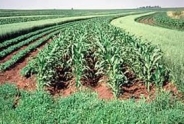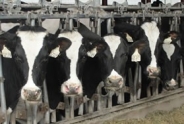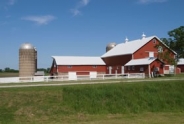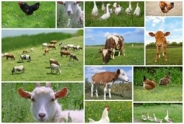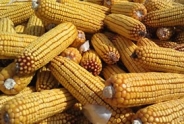Corn Ear Rots and Mycotoxins
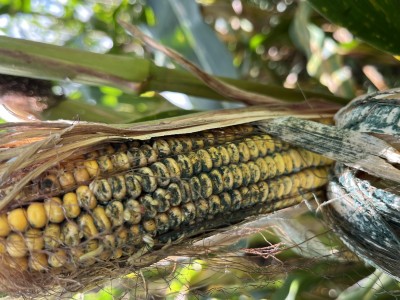
By Adrianna Murillo-Williams and Alyssa Collins, Ph.D; Penn State Extension
With corn harvest approaching, the combinations of different weather patterns impacting corn production raise concerns about ear rots, sprouting, and the risk of mycotoxin contamination. Mycotoxins are toxic compounds produced by fungal pathogens of maize (and other grain crops) that cause ear rots and decrease grain quality and silage. Contamination with mycotoxins occurs in the field when environmental conditions are favorable for disease development. At harvest, grain drying is critical to stop fungal growth and further mycotoxin contamination; however, since mycotoxins are highly stable, drying will not reduce the already existing mycotoxin levels in grain.
It is important to note that not all pathogens that cause ear rots produce mycotoxins. Before managing grain affected by ear rots and mycotoxins, you should correctly identify the type of ear rot(s) impacting your crop. There are many fungal species associated with ear rots. However, there are distinctive characteristics and scouting tips that you can use to identify the causal agent and to know if there is a risk for mycotoxin contamination.
The most common ear rots in Pennsylvania are:
Diplodia ear rot:
Caused by Stenocarpella maydis (Diplodia maydis) and Stenocarpella macrospora. Signs of the disease include a gray to brown mold mat that starts to develop at the base, middle, or tip of the ear and black specks (pycnidia) on the husks, shanks, and kernels (Figure 1). The causal agent can produce toxins called diplodiatoxins and chaetoglobosins that have been reported to cause intoxication in ruminants (diplodiosis) in South Africa, Australia, Brazil, and Argentina. However, there have been no reports of diplodiosis in the United States.
Figure 1. Diplodia ear rot. Photo credit: Gerald Holmes, Strawberry Center, Cal Poly San Luis Obispo, Bugwood.org
Gibberella ear rot:
Caused by Fusarium graminearum and favored by cool and humid weather conditions. Symptoms include a reddish discoloration that begins at the tip of the ear, where a red to bright pink mold develops toward the base of the ear (Figure 2). The fungus may contaminate corn with the mycotoxin deoxynivalenol (also known as DON or Vomitoxin) and Zearalenone, which can cause feed refusal and reproductive problems in farm animals, respectively. Many online resources have valuable tools for identifying Gibberella and sampling corn for DON.
Figure 2. Gibberella ear rot. Photo credit: Adriana Murillo-Williams, Penn State.
There are several other ear molds that we often see in Pennsylvania when conditions are favorable, including:
Trichoderma ear rot: Caused by Trichoderma viride and favored by excessive rain. Signs include a dark green mold growth that covers most of the ear (on and between the kernels), which can also be observed on the husks (Figure 3). No mycotoxin issues have been associated with Trichoderma ear rot.
Figure 3. Trichoderma ear rot. Photo credit: Gary Munkvold, Bugwood.org
Fusarium ear rot: Many different Fusarium species cause this ear rot. Signs include a brown discoloration or a white mold on scattered kernels (Figure 4). Affected kernels may also show a starburst pattern (white streaks radiating from the point where the silk was attached). Fusarium ear rot may lead to contamination with mycotoxins called fumonisins which are highly toxic for horses and swine.
Figure 4. Fusarium kernel rot. Photo credit: Gary Munkvold, Bugwood.org.
Penicillium ear rot: Several Penicillium species can cause this ear rot. Signs include a green-blue powdery mold between kernels near the tip of the ear (Figure 5). Different Penicillium species affecting different maize can produce mycotoxins. However, these are considered to be a more significant problem in silage.
Figure 5. Penicillium fungi growing on a corn ear. Photo credit: Adriana Murillo-Williams, Penn State.
Aspergillus ear rot: This ear rot is caused by the fungal species Aspergillus flavus and Aspergillus parasiticus and it is characterized by a dusty olive-green mold on kernels. The disease is favored by years with above-average temperatures and below-average rainfall. In addition to kernel damage, the risk associated with Aspergillus ear rot is the contamination with aflatoxins.
Figure 6. Aspergillus ear rot. Photo credit: Alison Robertson, Bugwood.org
Once you have identified the type (s) of ear rots in your field, you should assess the severity and the extent of the damage. Scout before harvest and pay particular attention to areas in your field exposed to the most severe weather conditions. If the risk of mycotoxins is high, you should contact your crop insurance agent and take a proper sample for mycotoxin testing.
If your corn tests positive for mycotoxins, that does not mean you have to dispose of it immediately. Depending on the levels of mycotoxins, there are maximum limits and recommendations that can guide you on what to do with the contaminated grain, in addition to local recommendations.
There are also recommendations for the next growing season that can help you reduce the risk of mycotoxins, including hybrid selection, insect protection, and residue management.
Upcoming Events
WNY Pastureland Conversion & Soil Health Field Day
July 16, 2025
Middleport, NY
Join American Farmland Trust for the Western New York Soil Health Field Day on July 16, 2025, at Zeliff Farm in Middleport, NY, from 9:00 AM-3:15 PM. Learn about pasture conversion, soil health benchmarking, biochar in grazing systems, and best grazing practices. Plus, enjoy hands-on demos with the NY Soil Health Trailer, drones, and cover crops! Check out the attached agenda for more information about the field day and REGISTER HERE. Zeliff Farms is a regenerative beef operation who has recently partnered with AFT on outreach and education to farmers including learning circles and evaluating biochar effects on soil health.
IPM Strategies to Protect Corn and Soybean Seed in NY
July 30, 2025
Hamburg , NY
SWNYDLFC and Cornell IPM are hosting a grower meeting to discuss integrated pest management strategies for protecting corn and soybean seed in New York.
FAMACHA Training for Sheep and Goat producers in Woodhull NY
August 13, 2025 : FAMACHA Training in Woodhull
Woodhull, NY
Join us for a discussion and hands-on training for internal parasite integrated pest management in sheep and goats. Certification is available to all students participating in the workshop.
Announcements
No announcements at this time.







